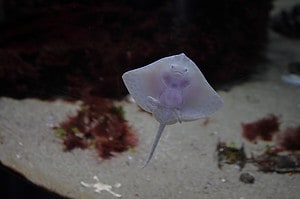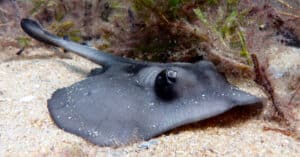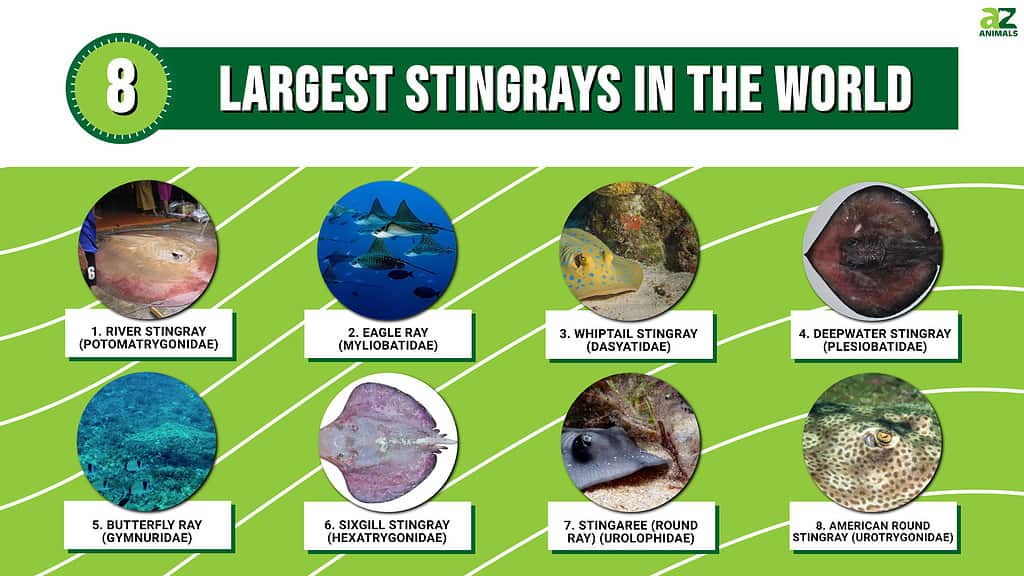
Stingrays are large, mysterious sea creatures. Often wider than long, these flat cartilaginous fish make up over 200 species and are organized into eight broad scientific groupings. Basic characteristics include a wide, flat body with a tail, spiracles (small openings that allow for breathing), and a stinger with venom. Despite their docile nature, stingrays will use their tail stingers when threatened. A stingray was responsible for killing the world-famous animal activist Steve Irwin aka the crocodile hunter. Ranging in size from less than a foot to nearly 10, let’s take a closer look at the 8 largest stingrays in the world today.
Stingrays, Manta Rays, Skates, and Measurements
While similar in many ways, manta rays differ from stingrays because they do not have a stinger. This article will focus exclusively on stingrays. Skates are related to stingrays as well but have been separated into their own family and will not appear on this list.
There are a few ways to measure the overall size of stingrays. Due to their unique body shape, disc width is used in combination with body length and weight. The tail lengths of stingrays vary dramatically, and tail length is sometimes included in body length, but since the vast majority of a stingray’s mass occurs in its disc area, we chose body length as the default length measurement. Tail length and size are included where the information is available.
Additionally, since many stingray species have not been properly studied, the list below organizes stingrays according to commonly accepted scientific groupings. The largest species of each grouping is listed. In some cases, comprehensive data is simply lacking.
8. American Round Stingrays (Urotrygonidae)
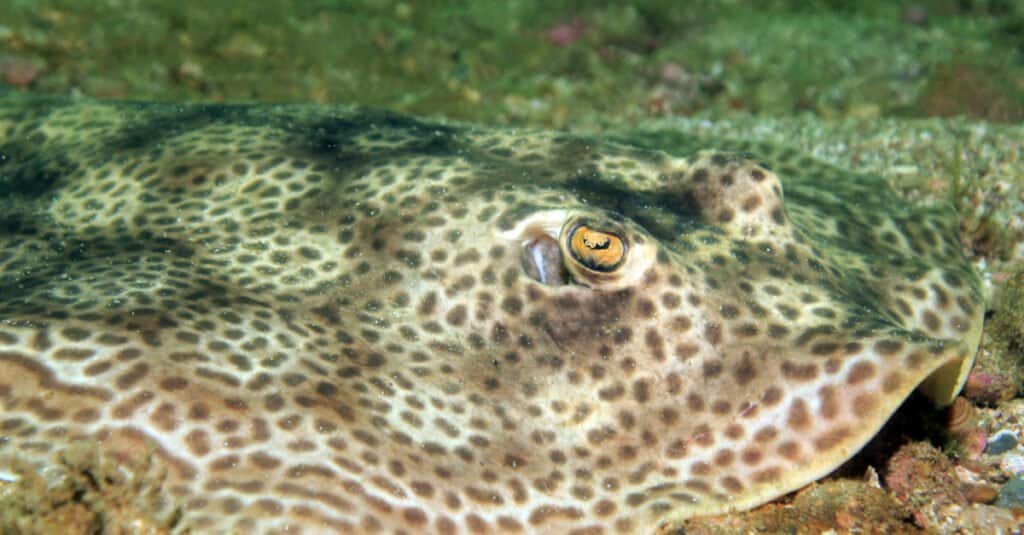
Round stingrays can be found in tropical and temperate waters.
©Daniel Lamborn/Shutterstock.com
- Yellow Stingray (Urobatis jamaicensis)
- Body Length: 26 inches (66 cm)
- Disc Width: 14 inches (35.5 cm)
- Data insufficient for average weight
Generally small, these round rays live in tropical and temperate waters near the Americas. These rays were once included with stingarees but have been separated into their own family. Many species of American round stingrays have not been closely observed, and the taxonomy is bound to change as more discoveries are made. Currently, the Yellow Stingray (while small) is the largest of the family. The Yellow Stingray has a conservation status of Least Concern and can be an aquarium pet, provided the aquarium is large enough. Like stingarees, the disc shape is rounder, the tails are slender, and they have a venomous spine that can cause painful injuries. Stingrays will not attack unless threatened but have the ability to do so and should be treated with caution.
7. Stingarees (Round Rays) (Urolophidae)
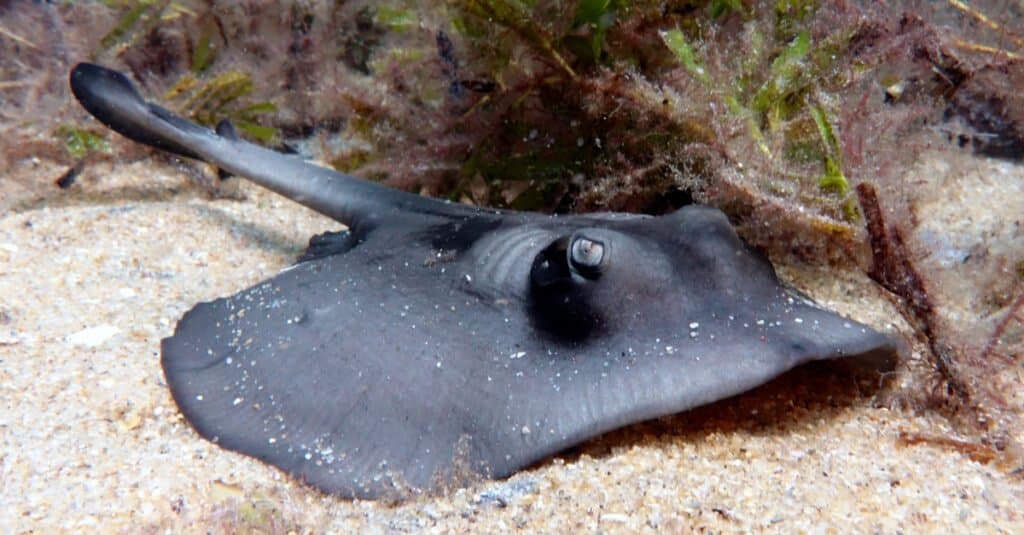
Stingarees are moderately sized stingrays that live in the Indo-Pacific region.
©scott plume/Shutterstock.com
- Sandyback Stingaree (Urolophus bucculentus)
- Body Length: 35 inches
- Data insufficient for average weight and disc width
Stingarees, also known as round rays, are medium-sized stingrays prevalent in the Indo-Pacific region. The waters around Australia are a hotbed for stingarees, with dozens of species identified. Stingarees are sluggish, bottom-dwelling fish with a disc shape oscillating from round to rhomboidal. They are fairly prevalent, and many species have a conservation status of least concern, according to the IUCN.
The sandyback stingaree is the largest of the grouping, though further taxonomic classification may change that. Due to accidental catches from commercial fishing vessels, this species has a vulnerable conservation status. Adults are usually yellow to brown in color; many also have small pale spots.
6. Sixgill Stingrays (Hexatrygonidae)

.
©CSIRO National Fish Collection / CC BY 3.0 – License
- Sixgill Stingray (Hexatrygon bickelli)
- Length: Up to 5.5 ft. (1.7 m)
- Data insufficient for average weight and disc width
A relatively new species, and the only species in the family Hexatrygonidae, the sixgill was first observed in 1980. It is the only member of its family and listed as least concern by the IUCN. This is a deep-sea dweller usually found from roughly 1500 feet to over 3600 feet below the ocean’s surface.
The sixgill can be differentiated from other stingrays due to the presence of six gills instead of the usual five. The sixgill also has a long, pointed snout and a hosepipe mouth loaded with 100 rows of small, blunt teeth. The habitat range of this flabby stingray extends through the Indo-Pacific region, with populations ranging from off the coast of South Africa to Japan, Australia, and isolated areas in the Pacific Ocean.
Scientists assume that the hosepipe mouth is used to hoover up food along the bottom of the ocean. Like many stingrays, the sixgill enjoys eating worms, clams, oysters, snails, shrimp, and other bottom-dwelling organisms. The biggest threat to the sixgill is accidental capture in commercial fishing nets. Generally speaking, the stingray is purplish-brown with white on the underside.
5. Butterfly Rays (Gymnuridae)
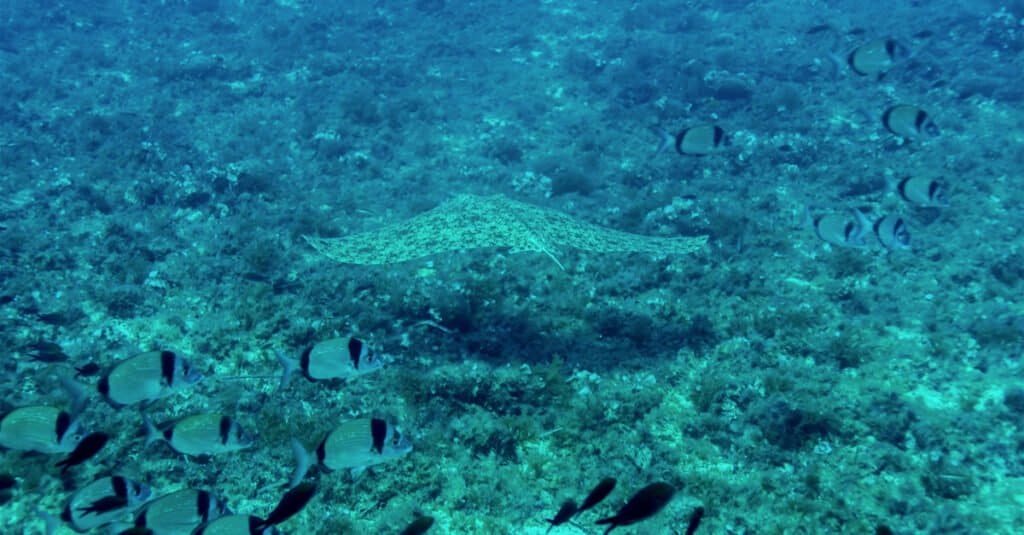
Butterfly
rays are present in Atlantic waters and classified as endangered.
©Pdrac/Shutterstock.com
- Spiny Butterfly Ray (Gymnura altavela)
- Length: 3-5 ft.
- Disc Width: 7 ft. 3 inches (Rare instance of 13 ft., unverified)
- Weight: Up to 130 lbs.
Butterfly Rays are a large grouping of stingray species, with the spiny butterfly ray emerging as the largest. Butterfly rays are found in Atlantic waters from the coast of Massachusetts down to Buenos Aires, Argentina. They are also prevalent on the eastern margin of the Atlantic from roughly Cameroon north to Italy and east to the Black Sea. The IUCN currently lists the spiny butterfly ray as endangered, although local populations in the Mediterranean and off the coast of South America are critically endangered.
With a large, rhombus-shaped disc, the spiny butterfly ray is much wider than it is long. Like similar bottom-dwellers, it relies on camouflage and surprise to hunt and prefers sandy ocean floors or brackish waters with muddy substrates. They usually sport a naked coloration and are generally not considered harmful to humans. Accidental stings have occurred from humans unintentionally stepping on them.
4. Deepwater Stingrays (Plesiobatidae)

The deepwater stingray has up to 60 rows of teeth.
©Bineesh. K. K / CC BY 3.0 – License
- Deepwater Stingray (Plesiobatis daviesi)
- Length: Up to 8.9 ft. (2.7 m)
- Disc Width: Up to 4.9 ft. (1.5 m)
- Weight: ~260 lbs.
The only species of its family, the deepwater stingray is a large, widely distributed ray in the Indo-Pacific. The deepwater is generally longer than it is wide, unlike the spiny butterfly ray. Generally, the deepwater has up to 60 rows of teeth, less than the 100 rows reported for the sixgill stingray. The IUCN currently lists the deepwater as the least concern.
Typical amongst rays, the deepwater enjoys feeding on small crustaceans, cephalopods (octopi, squid, etc.), and some bony fish, including eels. Kitefin sharks are known to prey on them. Scientists assume that the deepwater stingray is aplacental viviparous, meaning an egg grows within an embryo inside the female until it’s ready to hatch. However, comprehensive data about the stingray’s birth cycle is lacking. Most of the back half of the tail supports a long, leaf-shaped caudal fin.
3. Whiptail Stingrays (Dasyatidae)
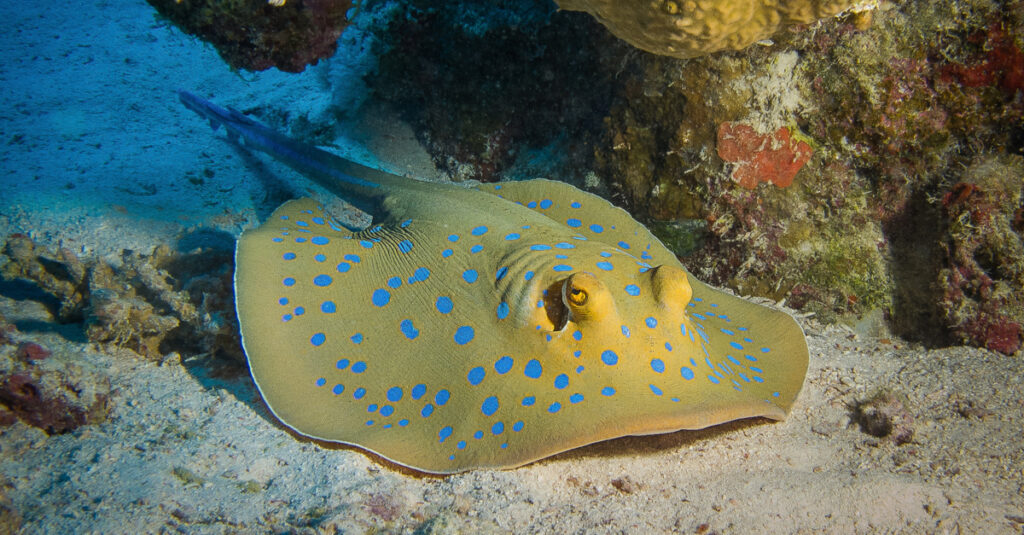
The blue-spotted ribbontail ray is a member of the whiptail stingray family.
©normansava/Shutterstock.com
- Smalleye Stingray (Megatrygon microps)
- Length: 10 ft. total
- Disc Width: Up to 7 ft. 2.5 inches (~2.2m)
- Weight: data insufficient
A large family of 35 species, Whiptail stingrays are common worldwide. They prefer tropical and temperate oceans as well as freshwater locations in Africa, Asia, and Australia. The largest among them and third on our list is the small-eye stingray. The small-eye has wide pectoral fins, large spiracles, small, wideset eyes, and a wide mouth. Because of its rarity, the IUCN does not have enough data to give the species an accurate conservation status.
Typical of whiptails, the tail of the small-eye is whip-like at its end. The ray is reddish-brown above, with the tail appearing darker and white below. There are also white spots beside the eyes. The small-eye is widely distributed in the Indo-Pacific region, although it is not clear if the regions where they’ve been spotted are connected or disjointed.
2. Eagle Rays (Myliobatidae)
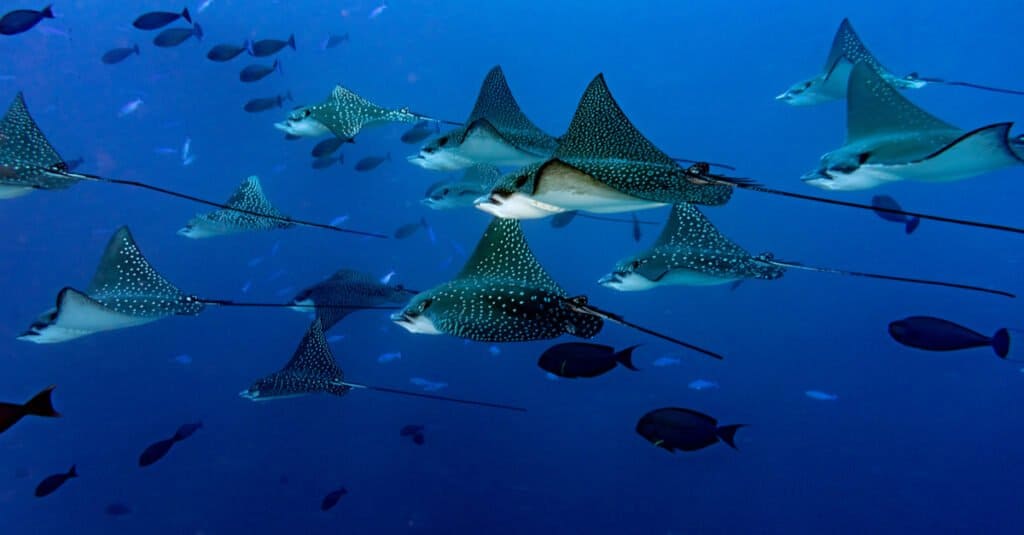
Eagle stingrays are able to breach the surface of the water up to several meters.
©Andrea Izzotti/Shutterstock.com
- Ornate Eagle Ray (Aetomylaeus vespertilio)
- Length: ~13 ft. (4 m)
- Disc Width: 7 ft. 10.5 inches (240 cm)
- Weight: data insufficient
Eagle Rays are a superb family of swimmers who can often breach the surface of the water up to several meters in the air, hence the “eagle” part of their name. These rays have an obvious rhomboidal shape and long tails. Like most rays, they use camouflage and stealth to prey on bottom-dwelling animals like mollusks, crustaceans, and certain fish. The Ornate Eagle Ray is the largest of the grouping, although that may change with subsequent discoveries. The Ornate Eagle ray is rare and has a conservation status of endangered by the IUCN.
1. River Stingrays (Potomatrygonidae)

River stingrays are the largest stingrays alive, as evidenced by this giant stingray caught in the Mekong River.
©Mekong on tour/Shutterstock.com
- Short-tailed Stingray (Potomatrygonidae brachyura)
- Length (including tail): Up to 20 ft.
- Disc Width: Up to 5.2 ft.
- Weight: up to ~490 lbs.
River stingrays contain the largest stingray species alive on earth today. They are more circular than other types of rays, and while the vast majority of the species live in freshwater, there are a few species of river stingrays (like the Chupare) that live in saltwater. This grouping of stingrays is found mainly in rivers of South America, and the taxonomy of species is still evolving as more data becomes available. The short-tailed stingray is the largest of the group, although not enough information exists to give it a conservation status.
River stingrays are covered in denticles; sharp, tooth-like scales on their backs. Most species of river stingrays also have the iconic stinger on their tails, which is periodically shed and regrown. Most stings are accidental but not entirely uncommon, and while death is rare, the discomfort and pain can be severe. The short-tailed stingray lives primarily in the Rio de la Plata basin, and its tail, while short, is very thick and muscular. Like most stingrays, the short-tailed feed on crustaceans, mollusks, and fish. The biggest threats to the short-tailed stingray are overfishing and habitat loss.
Summary of the 8 Largest Stingrays in the World
Here is a list of the 8 largest stingrays in the world:
| Rank | Stingray | Body Length |
|---|---|---|
| 1 | River Stingray | Up to 20 feet |
| 2 | Eagle Ray | Around 13 feet |
| 3 | Whiptail Stingray | 10 feet |
| 4 | Deepwater Stingray | Up to 8.9 feet |
| 5 | Butterfly Ray | 3-5 feet |
| 6 | Sixgill Stingray | Up to 5.5 feet |
| 7 | Stingaree | 35 inches |
| 8 | American Round Stingray | 26 inches |
The photo featured at the top of this post is © normansava/Shutterstock.com
FAQs (Frequently Asked Questions)
What was the largest stingray ever caught?
The largest stingray ever caught was on June 13, 2022. It was a Mekong giant stingray that weighed an astonishing 661 pounds! In fact, that stingray holds the title for largest freshwater fish ever caught.
Thank you for reading! Have some feedback for us? Contact the AZ Animals editorial team.



